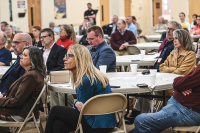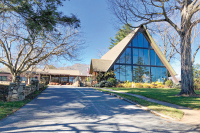Recount results in: Queen wins House race by a hair
Two weeks after the primary election, an official winner has finally been declared following a recount in an insanely tight race between two prominent Waynesville Democrats for the N.C. House of Representatives.
Joe Sam Queen beat out Danny Davis by a mere 17 votes — less than 0.002 percent of the 9,969 votes cast in the race.
“It definitely shows that one vote can make a difference,” said Lisa Lovedahl-Lehman, the director of the Jackson County Board of Elections.
While Democrats were clearly torn on which man they wanted to send to Raleigh, Queen said he is pleased to win.
“I want to pull together because this is an important year,” said Queen, who will now face the Republican opponent Mike Clampitt from Swain County come November.
Queen and Clampitt are vying for the N.C. House seat currently held by retiring Rep. Phil Haire, D-Sylva. The seat represents Jackson and Swain counties and the greater Waynesville and Lake Junaluska area of Haywood County. The district leans strongly Democratic.
The race between Queen and Davis came down to the wire on election night, with Queen emerging as the top vote-getter by a mere 11 votes. Queen’s margin widened to an 18-vote lead the following week after a few dozen provisional ballots and late absentee ballots were added to the results.
Provisional ballots are cast when poll workers can’t find a voter’s name on the roster of registered voters. They are given a provisional ballot, which is then set aside in a special stack until election workers have a chance to research whether the ballot should be counted.
A few late absentee ballots usually trickle in after the election as well, but as long as they are postmarked by Election Day, they get counted.
Davis then called for a recount — a right entitled to any candidate under state election law when a race is within a 1-percent margin.
In today’s era of computerized voting terminals, however, recounts rarely change the outcome. But, Davis did pick up one extra vote in the recount, discovered by election workers in Jackson County when hand counting a handful of paper ballots from voters who mailed in absentee ballots.
“They just didn’t do the bubble correctly,” Lovedahl-Lehman said. “The scanner wouldn’t read it, but the board members could look at it and see the voter intent was for Davis.”
Queen said he and Davis both ran fair, clean campaigns.
“It is by far the most pleasant election I have been through,” said Queen.
Republicans must face off in second primary
When none of the Republican candidates for Congress garnered 40 percent of the votes during the May 8 primary, the election got more complicated.
Rather than narrowing the long list of candidates to two — one Republican and one Democrat — the primary left Republicans with two candidates who will participate in a second primary on June 26. That delay could possibly give the Democratic nominee, Hayden Rogers, a head start going into the November general election as the two remaining Republican candidates, Vance Patterson and Mark Meadows, continue to duke it out for their party’s nomination for another six weeks.
“Does it make it more difficult? Yes. Does it make it impossible? No,” Meadows said.
The field was already overflowing with candidates from both sides of the aisle looking to snatch up the seat of departing Congressman Heath Shuler, D-Waynesville. Eight Republicans lined up to fight for the position, while three distinct Democratic candidates jumped into the ring for a comparatively easy battle amongst themselves.
With so many Republican candidates, it was difficult for voters to distinguish most of them from Adam. So, when May 8 finally rolled around, voters in the Republican primary split their ballots too many ways.
Meadows received nearly 38 percent of the votes — just 2 percentage points shy of the need 40 percent for the nomination. Meanwhile, Patterson, who garnered 23.6 percent of the votes, will have a second chance in a runoff.
Meadows, 52 of Cashiers, is the candidate who drew the short end of the stick, said Chris Cooper, an associate professor of political science at Western Carolina University.
“It’s a good day for Hayden. It’s a good day for Patterson. It’s not so good a day for Meadows,” Cooper said. “It has complicated Meadows’ life.”
A second primary means a divide in campaign funding and volunteers and no one for the Republican Party as a whole to gather their support behind.
“You are splitting everything a campaign needs between two candidates,” Cooper said.
Although a runoff is not the ideal situation for Meadows, the May 8 primary showed that he has a broad base of support. Meadows won the majority of votes in all but four counties in the district.
“It doesn’t mean he will win, but he is clearly the frontrunner going forward,” Cooper said.
Meadows will have to make a strategic decision — to run against Patterson only until June or position his message as if he has secured the nomination, Cooper said.
Although he hit a snag, Meadows said his strategy for the election will not change, and he will continue to focus on appealing to all voters, not just one group.
“Instead of talking about other candidates, we have talked about our message,” Meadows said. “We are going to go ahead with our message — less government, less spending.”
As for Patterson, Cooper said his best option is to focus on the runoff race.
“Patterson needs to aim to beat Meadows, and Meadows has a tough choice to make,” Cooper said.
And, that is exactly what Patterson said he plans to do.
“A lot of the work’s been done,” said Patterson, who started the race with little to no name recognition. “I just need to make sure I can differentiate myself from Mark (Meadows).”
In most cases, second place is a disappointment, but for Patterson, runner up in the Republican congressional primary is exactly what he was aiming for.
“We are really where we hoped to be,” Patterson said. “We were hoping to make the runoff.”
Patterson said he thinks that he can close the gap in support during the next six weeks.
“Why would I not continue on? We’ve got good momentum,” Patterson said. “We made the playoffs, and when your team makes it into the playoffs, anything can happen.”
Meanwhile, the Republican Party is in a difficult position since it cannot officially support anyone until a nominee is chosen. The Democratic Party, however, can start putting its political weight and funding behind Hayden Rogers, a Blue Dog Democrat and former chief of staff to Shuler.
“It puts us at a tremendous disadvantage,” said Ralph Slaughter, chair of the Jackson County Republican Party. “It would make it much easier if my job was supporting one person as opposed to two people.”
The cost of a runoff
Close races come at a cost — a steep cost for cash-strapped counties that can ill afford to stage a special “do-over” election when no clear victor emerges the first time around.
When there’s a crowded field, as there was in this year’s Republican primary contest for Congress, if none of the candidates secure at least 40 percent of the votes cast, the runner-up has the right to call for a special run-off election.
And that means county taxpayers must foot the bill. How much?
“More than $25,000 and probably close to $30,000,” said Robert Inman, director of Haywood County’s Board of Elections. “We are looking at a major expense.”
Jackson County’s board budgeted $25,000 to cover the cost of any runoffs this year, but it is unclear if it will need to find more.
“It’s just really hard to tell,” said Lisa Lovedahl-Lehman, director of the Jackson County BOE. “I base (the amount) on past years.”
Haywood County hasn’t budgeted any additional money specifically for such cases.
“We just kind of have to pay those bills as they come along,” Inman said. “Haywood County has not budgeted any (funds) at all, not one penny.”
Instead, the money is a mixture of any leftover elections funding and county contingency funds.
The Macon County’s Board of Elections estimated its cost to be between $20,000 and $25,000.
Cost depends on a number of variables: How many runoff elections there are? How many machines and employees will be required to man the polls? How many early voting sites must it operate? Are there runoffs for both Democratic and Republican races, which would up the number of ballots needed?
“You are basically turning around and doing another election,” said Joan Weeks, director of the Swain County Board of Elections.
The Swain County board will have to return once again with its hands out to the Board of Commissioners to help pay for any runoffs. The election board approached the commissioners earlier this year asking for money to pay for an early voting site in Cherokee. Now, it will go back for more funding. The total cost of an election in Swain County is between $6,000 and $12,000.
Primaries typically report low turnouts anyway — ranging from 12 to 30 percent during the past decade.
For runoffs, or secondary primaries, voter turnout numbers are far lower. Runoff turnouts are anywhere from 2 percent to 12 percent of registered voters, Lovedahl estimated.
It is nearly impossible to replicate the emotion that first drove voters to the polls for the primary or that will drive them to the polls come November.
“You can’t change the emotion that they had the first time,” Inman said.
“The cost leaves some wondering if the restrictions are too tight. I wonder if there is not perhaps a better way.” said Ralph Slaughter, chair of the Jackson County Republican Party.
Sediment foils irrigation systems at worst possible time
During the past three weeks, tomato farmers in the Thomas Valley near Whittier have been unable at times to run drip irrigation equipment to counter drought conditions because sediment in the Tuckasegee River was clogging their pumps.
“With the 90-degree days, it’s really critical that these farms get drip irrigation,” said William Shelton, who runs a vegetable farm in Thomas Valley. “That river’s our lifeblood when it comes to these crops. Particularly during drought.”
Tomatoes are 85 percent water. When the plants are overstressed, they will actually take water back from the fruit, ruining the crop.
Kent Cochran, who farms 20 acres of tomatoes just up the road from Shelton, doesn’t understand how the river can be full of mud when there is no rain.
“When it rains, there’s going to be mud for a day or two but that’s not really an issue,” Cochran said. “We’ve been needing the water bad these past three weeks, and sometimes we go over there and it’s clear, and other days it’s mud.”
Robbie Shelton, the Jackson County erosion control officer, has been equally perplexed. Shelton’s job includes monitoring construction sites that could dump sediment into the river.
Last week, Robbie Shelton traveled up and down the river in search of an answer to the farmers’ questions. The focus of his investigation was Duke Energy’s efforts to restore the streambed above and below the former site of the Dillsboro Dam.
Shelton took pictures during the first week of July that showed the river was clear above the dam and increasingly turbid below.
“The Tuck upstream of the dam is clear. It’s downstream that it’s muddy,” Shelton said.
Shelton said during the drought, the river was increasingly muddy as it moved downstream towards Barker’s Creek.
“The closer you get to Thomas Valley the dingier it gets,” Shelton said. “It’s a progression. I’ve tried to find a source, and there’s not been one that’s been found.”
Nate Darnell, who works an 8-acre tomato field in Thomas Valley as part of his North Face Farm, has tried to bring some levity to an otherwise worrisome situation.
“As a farmer, I have to deal with a lot of runoff regulations, and it strikes me as ironic that the upstream runoff from development is causing us the problems now,” Darnell said
The restoration of the stream bank at the former Dillsboro Dam site is monitored daily by personnel from Duke Energy in accordance with the Clean Water Act and overseen by the N.C. Division of Water Quality.
Duke has been monitoring turbidity below its work zone. It has not exceeded state standards. In fact it has been well below them, according to Duke spokesperson Jason Walls.
“The turbidity and the sediment in the river are coming in from other places,” Walls said. “We feel confident that our operations aren’t increasing the levels of sediment.”
If the dam site isn’t causing the sediment, then what is?
That’s the question Cochran and Darnell are asking. Darnell has observed that on dry days the river gets turbid in the middle of the day.
“It was coming on down here about midday, anywhere between 11 a.m. and 1 p.m.,” Darnell said. “I really can’t give you a good reason, but I could speculate.”
So far this summer, Darnell estimates he has lost between one and three tomatoes from each of his plants. By the end of the season, those losses could add up to $25,000 in lost crops.
Darnell said farmers are constantly dealing with loss, whether from drought or insects or crows, but having the cause be the river that is the valley’s lifeblood is mystifying.
“The river’s not always going to be clear, but we really shouldn’t have to fight it during drought,” Darnell said.





